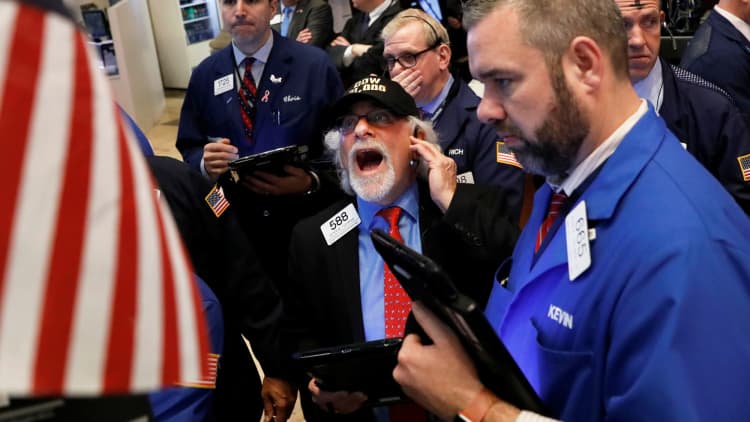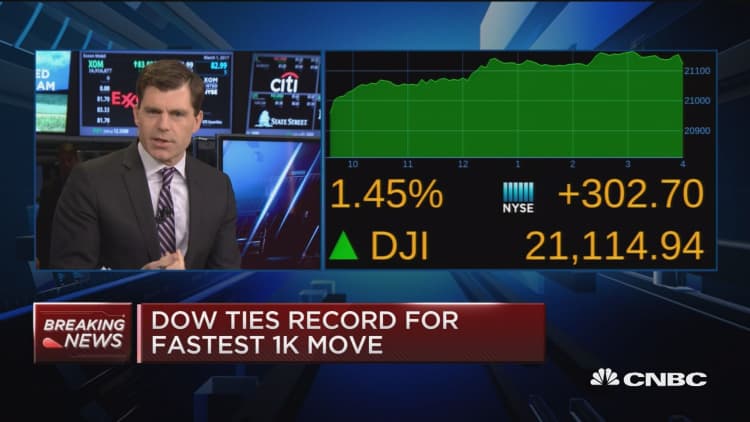
March roared in like a lion on steroids, fitting for the month that marks the eighth anniversary of the second longest bull market in history.
Jumping on the reflation trade, stocks rallied hard, smashing records across the board Wednesday and setting up for further gains. That's thanks in part to a boost from President Donald Trump, who offered few details before Congress on Tuesday night but provided enough encouragement for markets to believe he will scuttle regulation and bring about tax reform and fiscal stimulus. It was also due to the fact that Fed officials are actively talking about the potential for a March rate hike, which is adding fuel to the gains in financial stocks.
Trading in the rest of the month may not be quite as buoyant, and there are plenty of macro risks for the market, as well as catalysts. There is a Federal Open Market Committee meeting, ahead of which Fed officials have been suggesting a rate hike is on the table. They have succeeded in shifting market expectations dramatically in recent days with Fed funds indicating about a 70 percent chance of a rate hike.
One of the first events of March is the heavily oversubscribed Snap IPO, which priced at $17 per share and would value the Snapchat company at about $24 billion. It is the first big tech IPO since Alibaba went public in 2014, and it is expected to begin trading on Thursday.
"In the recent past, these high-profile tech sector IPOs have been hit or miss," said John Canally, economist and market strategist at LPL Financial. "This particular one is coming at a time when the market already is at an all-time high. … It may lead to a situation where individual investors feel like they're being left out. There's plenty of capital sloshing around and I think it would be dismissed as a company-specific situation if it doesn't go well."
But the IPO pipeline is full after a period of drought. "If Snap does well, I think that'll be a green light for a lot of tech IPOs," said Eddie Perkin, chief equity investment officer, Eaton Vance.
The Snap IPO begins its life in an exuberant market, which saw its highest volume of the year Wednesday.
The Dow started March by breaking through another large, round number — 21,000, just 24 trading days after breaking 20,000. That is the fastest century run for the Dow since 1999 when it also gained 1,000 points in 24 days, but from a much lower level of 10,000.

"It signals much the same as what breaking 20K meant…these highs will get more publicity and that will drive greater participation in markets, especially from retail investors, who still hold too much cash," wrote Sameer Samana, global quantitative strategist at Wells Fargo Investment Institute.
The Dow closed up 303 at 21,115 Wednesday, its best since December. The jumped 1.4 percent to a record 2,395, after briefly reaching the psychological 2400 level, and the Nasdaq soared 1.4 percent to a record 5,904.
March is busy with major events for markets, like the Chinese National People's Congress starting Monday. Some traders are looking to see if economic forecasts for China have been lowered and could therefore impact commodities markets. There are also meetings March 9 of the European Central Bank and EU leaders, who may hear the official word from British Prime Minister Theresa May that the U.K. is leaving the euro zone.
The upcoming French election in April could generate some noise to ruffle markets in March, and there is also the Dutch election March 15, where until recently a populist candidate looked set to win. The French election would provide most risk for the euro zone if nationalist candidate Marine Le Pen were to win. Le Pen has vowed to move France off the euro, but for now she is not seen as the likely winner.
"I'd say the greatest uncertainty around what is happening is the Fed. I feel pretty confident the Dutch populist is not going to win. I feel confident May is going to trigger Article 50. I don't think the EU summit amounts to much," said Marc Chandler, chief currency strategist at Brown Brothers Harriman.
The Fed's next interest rate hike has long been expected for June, but Wall Street has been nudging back expectations to March and May because of recent comments from Fed officials, who see inflation rising near their 2 percent target and a healthy jobs market. February employment on March 10 will be the final big report for the Fed to consider before it begins its two-day meeting March 14.
Chandler said he doubts the Fed would raise in March and it may be setting up for March, but the markets have been quickly repositioning for March. "I still lean against it, and the reason I lean against is the discipline in the FOMC statement is the clearest articulation of what the Fed is going to do," he said, adding there was no suggestion of immediacy in the comment.
Treasury yields have been rising and got another boost late Tuesday and Wednesday after New York Fed President William Dudley joined the chorus of Fed speakers who say the Fed could consider a hike. The note yield was at the highest level since 2009, and it is the most affected by Fed rate decisions.
Dudley is considered closer to the core of the Fed and more important than other presidents, but the market is really waiting to hear from Fed Chair Janet Yellen who speaks Friday and Fed Gov. Stanley Fischer, who also speaks that day.
The U.S. also has an important midmonth fiscal deadline when the legislative suspension of the debt ceiling runs out. That should put the focus on budget talks and therefore also the progress of tax reform. The government would still have funds available to avoid default into the summer months. There could be some verbal fireworks over it, but it is widely expected the Trump administration and Congress will work through it without the past grandstanding that shut the government down.
Another factor traders will focus on this month is the endurance of the bull market itself.
"It's hard to imagine a better month than where the Dow rallies to records 12 days in the month, and where the S&P is only down four times," said Chandler.
If history is a guide, March should be a decent month. Sam Stovall, chief investment strategist at CFRA said March is usually a good month for stocks and the S&P 500 is up 1.4 percent on average. "The S&P jumped 3.7 percent in February after rising 1.8 percent in January. In the 27 years since 1945 that the S&P rose in both January and February, the S&P recorded a positive full year return 27 out of 27 times, averaging a total return of 24 percent," said Stovall. "In the subsequent March, the S&P gained 1.2 percent and was up 70 percent of the time."
Stovall also said the bull market is the second longest in history, after the bull market of December 1990 through March 2000. "It was a nine year plus. We are now the second longest bull market since World War II. If it ended today, it would be the second most expensive. The bull market of 2000 topped out with a P/E of 30 times. This one is at 25 times trailing," he said.
Bank of America Merrill Lynch analysts Wednesday raised their year-end target on the S&P 500 to 2,450 from 2,300 for year end. Their reasoning was not as bullish as it sounds. The analysts said the raised their target because they see an end coming for the bull market.
"We think the market still has the potential to move higher as investors capitulate into equities; note that the "Great Rotation" out of fixed income into equities has yet to happen," wrote the analysts. They noted they've been expecting a wide range. "[I]nvestors are likely better served focusing on the internals of the market rather than a year-end number. And for longer-term investors, elevated valuations and high leverage today should shift the risk-reward balance to the market to more risks than were evident a few years ago," they added.
Stovall said he's leery of the rush into stocks, as investor sentiment rises. "I'm more concerned with the mindset today of the fear of missing out, FOMO. All of the bull markets ... they all go out with a bang. They don't go out with a whimper," said Stovall. He said stocks usually have a double-digit gain before the end of bull market. "We're currently up 20 percent in from March 9 of 2015.
What to Watch
March 2
Snap IPO trades
March 3
Fed Chair Janet Yellen and Fed Vice Chair Stanley Fischer speak at separate events
March 5
Chinese National People's Congress
Weeklong CERAWeek conference begins in Houston, attended by major oil company executives and oil ministers from Russia, Saudi Arabia, Iraq among others
March 9
Eighth anniversary of bull market
Start of 2-day EU summit where Britain could trigger Article 50, officially starting its exit from the European Union
European Central Bank rate meeting
March 10
U.S. employment report
March 14
2-day Fed meeting begins
March 15
Dutch election
FOMC statement and forecasts
March 16
President Trump's budget expected
March 17
US deadline for dealing with debt ceiling
2-day G-20 finance ministers meeting in Germany
March 25
EU summit
Correction: An earlier version of this article misstated the date that the Federal Reserve's two-day policy setting meeting begins. It begins on March 14.


